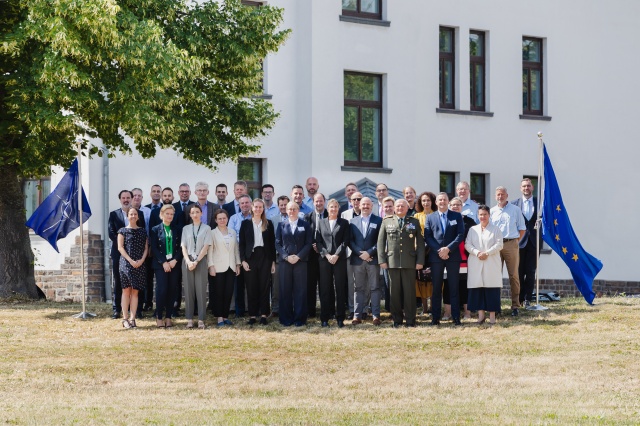
Article: Janet Licht, Dirk Hagemeister
Cooperation and CivMil Engagement for Resilience in Alliance Defense (CERA)

CERA 2023 Workshop Logo (source: MMCC/EMC)
Cooperation requires an understanding and knowledge of each other!
The experiences during the Covid-19 pandemic and Russia’s invasion of Ukraine clearly showed that the management of this kind of events requires civil-military cooperation. Therefore, it is necessary to establish an understanding of the existing and required structures for cooperation and coordination.Important questions that arise at different levels again and again are: What can be specifically derived and transferred from the experience of previous international crises, conflicts and disas- ters in the case of a collective defence event as covered in Article V of the North Atlantic Treaty Organisation (NATO)? Where is it required to rethink the current processes? Is there sufficient situational awareness and understanding between the civilian and military medical stakeholders in case of a collective defence? The Multinational Medical Coordination Centre/European Medical Command (MMCC/EMC) is a multinational coordinating entity within the field of medical support for its participating nations as well as institutions and headquarters of the European Union (EU) and NATO. One of the main tasks of the MMCC/EMC is to strengthen civil-military medical cooperation and resilience. Resilience is both a national responsibility and a collective commitment, rooted in Article 3 of the North Atlantic Treaty and affirmed in the Strategic Compass of the EU. With this in mind, the MedSA/CivMil Branch of the MMCC/EMC organised the CERA Workshop in Koblenz/DEU in mid-July 2023. The successful two- day-workshop focused on possibilities for a cooperation between civilian and military medical institutions in the event of a collective defence. The aim was to gain a better understanding of the existing structures and their interactions and, based on this, to develop recommendations that can serve as a catalyst for further progress in this critical area. Participants of the workshop were from numerous NATO and EU member states. Presentations were given by international speakers of civil and military organisations, government entities, and health care structures.
It was shown that lessons have already been identified from the experience of critical events in recent years. Some of the concepts and structures presented were developed during the Covid-19 pandemic. Key words in this context are “Surge capacity” and “Readiness”. Surge Capacity is the ability of a system or organisation to rapidly expand its capacity/capabilities or resources in response to an increased demand or an emergency situation during mass casualty situations and disasters. Readiness means being prepared and able to react to critical events. ROU Secretary of State Dr. Arafat and chairperson of the NATO Joint Health Group (JHG) presented his experiences as Head of Department of Emergency Situations, Ministry of Internal Affairs, in Romania. He pointed out that they didn’t have experience, stockpile, and material, when ROU started to develop capabilities and readiness, but they had to find solutions. He presented examples from recent activities during the Covid-19 pandemic and the Turkiye earthquake relief operation, but also from exercises which included civil and military participants from different countries. A representative of the Dutch Ministry of Defence (MoD) introduced the concept of the Major Incident Hospital in Utrecht, a collaboration between University Medical Center (UMC) Utrecht, Dutch MoD and Ministry of Health, Welfare and Sport. As an example of creating surge capacity in close civil-military cooperation, it is an internationally unique facility for providing immediate emergency care for casualties in exceptional circumstances. Brigadier General (MC) Dr Kowitz, Director of the MMCC/ EMC, presented the role of the MMCC/EMC and the military perspective. He emphasised the medical challenges a collective defense scenario would create for the host-nation(s) with massive force deployments.
As expressed by many participants from civil organisations, the civilian partners often lack a basic understanding of potential defence scenarios in terms of the types of threats, the massive and continuously occurring numbers of patients and the responsibilities in an armed conflict. Therefore, it is important to be aware of the differences between public and military health services and to acknowledge them. Who are the decisionmakers and other stakeholders to be engaged in the preparation of bridging the gaps? As part of a successful deterrence, civil- military cooperation and interfaces have to be increasingly considered as relevant in the preparation and training. It is necessary to build an understanding across the cooperating partners and to define the requirements and interdependencies. To gain a better understanding of the medical requirements and interactions in an Article V scenario, it might help to give the civil side examples they can relate too. A positive example of a civil-military cooperation in Germany is the cooperation agreement between the Federal Office of Civil Protection and Disaster Assistance (BBK) and the Joint Medical Services Headquarter through weekly contacts of liaison officers.
The World Health Organisation (WHO) published the guidance document “National civil-military health collaboration framework for strengthening health emergency preparedness”. It also conducts Civil-Military Security Mapping (CMAP) of capacities and capabilities which aims to identify key areas for collaboration and addresses gaps and needs.

Participants of the CERA 2023 Workshop (source: PiZ SanDst/Bundeswehr)
Interoperable communication systems are needed that work with a common data minimum and through which data can be exchanged between military and civilian medical providers. In this regard, the representative of the JHG that coordinates the efforts for disruptive health crises with civilian stakeholders for health care and civil protection and translates the NATO’s level of ambition for national and collective medical resilience, gave an overview of the documents/guidance already prepared by the JHG and of the working papers that are planned on the topic of “patient evacuation (minimum information requirements/ patient tracking)” and “levels of care/crisis standards of care”. The WHO described the efforts to evaluate emergency medical teams (EMT) provided either by civilian or military organisations in an attempt to ensure standards in disaster relief.
Effective, multidimensional national and transnational transport systems for both patients and materials are a basic requirement. The BBK presented the so-called „Cloverleaf Concept”, i.e. health protection in civil defence with a spotlight on Germany’s preparations and plans to improve resilience in health care. Put in place during the Covid-19 pandemic, it coordinates strategic patient transfers and distribution according to care regions in Germany. With regards to Russia’s invasion of Ukraine and the MEDEVAC assistance for UKR it became apparent that the system had to be adapted. The Dutch National Coordination Centre for Patient Evacuation was set up with the support of the Royal Netherlands Army to assist regions with distributing patients across acute care departments during the Covid-19 pandemic. Their IT tool “Patient Movement Request” has been further developed to maintain track and trace of the patients. Medical logistics is a key issue in the event of crisis scenarios. Questions that need to be answered in this context include: Where does stockpiling take place? To what extent? Are the supply chains secured? Some presentations included elements on stockpiling solutions that are already in place. The Directorate General Health Emergency Preparedness and Response (DG HERA) and the BBK are good examples of “Readiness” in this context. DG HERA is a new EU Commission-led organisation which analyses, identifies and focuses on possible health threats. Based on this assessment, it sets out a strategic approach for the development and stockpiling of medical countermeasures and medical supply together with EU Member States and EU Institutions. The mission is to reinforce global health security and strengthen Europe’s ability to prevent, detect, and rapidly respond to cross-border health emergencies. Work is currently in progress regarding the development of the “Medical Countermeasures Stockpile”. The principle of the medical supplies stockpile in the German „Cloverleaf Concept”, where hospital pharmacies of existing facilities serve as hubs for the stock and the continuous turnover is ensured at the same time, was explained by the BBK representative. This is a different approach in comparison with the stockpiling of the Major Incident Hospital Utrecht where it is done separately and for a capacity of 5 days.
The excellent examples of best practices, the observations and “Lessons Identified” collected during the workshop have the potential to be used or adapted in a dual-use approach for military conflict scenarios in Europe. A clear need is the creation of surge capacity in health arena for a multi-domain and large- scale warfare with a high throughput of non-combat and combat casualties. Participants agreed that civil-military cooperation is essential, but needs time to be implemented and requires further planning, meetings and training to raise awareness and pre- paredness. The attendees agreed that a vignette-driven table top exercise/wargame with a focus on the civil-military cooperation between EU and NATO institutions and headquarters would be beneficial. The sharing of existing best-practice models will facilitate these developments. An ongoing, active communica- tion and cooperation between civilian and military players will help to refine our collective understanding and find innovative approaches to the challenges we face.
The CERA Workshop provided an outstanding opportunity to strengthen the relationship and cooperation between the civilian and military medical stakeholders. MMCC/EMC will facilitate this process with another WS in 2024.
Authors:
LTC (OF-4) Licht, Janet
CDR (OF-4) Hagemeister, Dirk
MMCC/EMC, MedSA/CivMil Branch
Andernacher Str. 100, 56070 Koblenz
Date: 06/25/2024
Source: European Military Medical Services 2023











